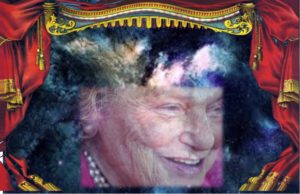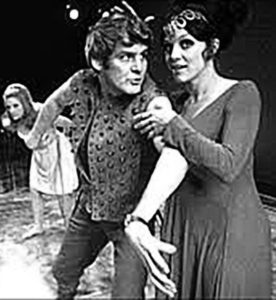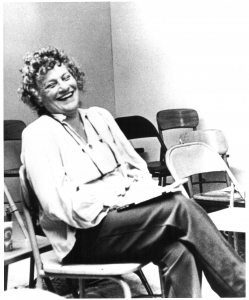
SPACE: Something about which we know very little; the stage area where a reality can be placed; space can be used to shape the realities we create; an area of no boundaries; without limits; the player uses space to bring reality into the phenomenal world; to make space for the object; the larger environment; the space beyond; a place to perceiver receive communication. – from Improvisation for the Theater, Viola Spolin, Northwestern University Press.
Viola Spolin once told me that her awareness of Space as a foundational concept in her work coincided with her reading of Carlos Castaneda’s The Teachings of Don Juan: A Yaqui Way of Knowledge; A Separate Reality; and Journey to Ixtlan and her own experimentation with peyote. Castaneda describes the unknown in these books as a ‘non-ordinary reality’, and as you can see from Viola’s definition of Space in the above quote, it is much more than one thing.
In Viola’s workshop, because I was a mime, I gravitated to the idea of space objects, but Viola always pointed out to me that mime was not so much use of space as choreography. I didn’t understand this difference until she pointed it out to me in the exercise Begin/End, which she developed to help students sharpen up their use of space objects. As a mime, I could describe in space any object easily and thought that was the point. When I did this exercise (in my opinion, extremely well) she asked me a simple question: “Did you really see that object? Or were you drawing us a picture?” I responded that I drew the audience a picture. “And it was a very nice picture, honey.” She told me. “We saw it. But you didn’t.” ‘How did she know?’ I thought to myself. It was true. I saw the basic outlines and could translate that into movement that would make the object appear to the audience, but it was an illusion – a term used in mime to approximate an effect, like walking against the wind or describing a wall. I liked to perform these illusions and I was pretty good at it.
I describe this in more detail in my blog post Out of the Head and Into the Space. After my experience with Begin and End, I understood that Space is tangible, visible (with proper focus) and shareable with an audience. It is more than making an audience see objects and honoring the invisible thing you created, it is a shared ‘non-ordinary reality’ that allows worlds to appear on an empty stage and builds sets for the actors to inhabit. It has the potential to be hyper-reality – a true appearance of something not imagined. From my work with Viola, those places and things remain in my memory more vividly than actual reality. If you’ve experienced this at any level, you are forever transformed by it.
Dick Schaal: Master of Space 
The concept of space substance and the idea of the stage space as the field upon which the players play was never more exciting than when performed by one of Paul Sills’ master players, Richard Schaal. I was lucky enough to sit in on some rehearsals of Paul Sills while he directed his new company of veteran players in Hollywood in 1983. He had called some of the original members of his Second City and Compass players to work with him in a new venture which eventually became Sills and Company, a group that performed Viola Spolin’s theater games regularly in Hollywood at their own theater, the Heliotrope.
My mime partner and I watched, enthralled one afternoon, as they ran through some Story Theater scenes. They were working on Tales of the Arabian Nights and the legend of The Highwayman. The cast included Richard Schaal, Hamilton Camp, Richard Libertini, Lewis Arquette, Mina Kolb and Avery Schrieber.
This rehearsal took place at the Pilot Theater (now long gone) on Santa Monica Blvd., in a black box-style theater. There was nothing but a black floor and black walls and drapes. What I witnessed was nothing short of a miracle. Since it was a rehearsal, no one had any costumes at this point, but I still see them clothed in the garb of the story. Schaal was a rascal disguised as a sultan, sneaking into the sultan’s harem. He made his entrance and told the audience of his plan. All he did was reach into the space to grab an invisible curtain and part them to peer into the harem.
But I saw what he saw – A yellow and white tiled sanctum with columns reaching to the ceiling, calm water pools with beautiful lilies floating in them and tall jugs of wine and perfumed oil. He emerged onto the stage and Hamid (Hamilton) Camp rushed onstage as a eunuch and slid to Schaal’s feet prostrate in a low bow. “What is your wish, effendi?” he cried in a piercing, obsequious wail. “Not to look upon my face. Attend me!” Schaal replied. Camp ran to a tall jug, almost as tall as he was and struggled to anoint the sultan’s feet. Mina sauntered onstage as a wayward harem girl and the scene went on.
My friends that was over thirty-five years ago and I can still see it as vividly as if it were in IMAX and Technicolor.
What I saw at that rehearsal was what Spolin calls true use of Space. It was more than the clever use of pantomimed objects – it was a new reality. In the years since I’ve spoken to Dick Schaal who liked to describe Space as the geographical location of creativity. I heartily agree.
Rx for IMPROV Today
What Modern Day Improv Lacks is the understanding of how to make use of Space to this degree. It is an essential ingredient in Spolin’s Improvisation and one that is seriously ignored. My suggestion for most improv schools and theaters would be to explore this area fully. The many games of Where and What’s Beyond the Where, Environments and Object work found in Spolin’s Improvisation for the Theater deserve much more emphasis.
Without this ingredient, Improv is tied down by over verbalization with an emphasis on character and dialogue taking place most likely on a bare stage, forcing the audience to imagine what could be seen, rather than sharing that invisible reality.

This is a great post about the value of space. When I began studying Spolin work, I thought, “how will this work without props?” But as I explored, I found it be quite freeing, because (as you’ve often said, Gary) the space will provide what you need. I’m very much still learning to *use* the space rather than to draw a picture with it, but it’s been fun to see what the space gives – sometimes it’s just what I need, and sometimes it’s something surprising that makes for an interesting encounter.
“Play Ball” was the first space game that I played. I love the side coaches, “Give the ball its time in space” and “See the ball in space and not in your head.” When I first read Improvisation for the Theater – this was before I had played any of the games – I thought, “oh, that’s a neat exercise.” Now I realize it’s a great gateway game to delve further into the use of space. My first “a-ha” moment with space was when I was juggling space balls and had to find a place to set them down before continuing with another part of the scene. I certainly agree with your Rx for modern improv, and that experience I just described makes me think how vital it is to have Spolin teachers leading players through these games, because there’s no substitute for the experience.
I find it interesting that the first line of Viola’s definition of space is, “Something about which we know very little.” Yet, it plays such a fundamental role in workshops, from space walks to discovering and using space objects to establishing the where to giving players a shared platform on which to connect. Perhaps that’s its power, that we don’t control space (maybe that marks a difference from pantomime?) but that we have to develop an appreciation for it as part of the “accessible intuition” that the games build – an appreciation of and accessibility to space that still does not pretend to suggest that we fully understand or anticipate the gifts that it provides. Or maybe that it has a unique power to connect us together as players (even in an online world, we can still share the same space).
Just some musings. I can’t imagine doing improv work without the support space provides. And I’m glad to accept it, as a place to be out of my head.
When you play Viola’s games, you understand their value. Gary Schwartz is a gifted teacher of Viola’s work.
Gary I have been studying Viola Spolin for years and it is incriduble to find your writings. I teach Improv classes and have been on a mission to stay true to the original teachings of Viola Spolin. I have been reading your writings and I am blown away. Is there any possibilty of having a call with you sometime? Or do you teach any classes? Thanks so much!